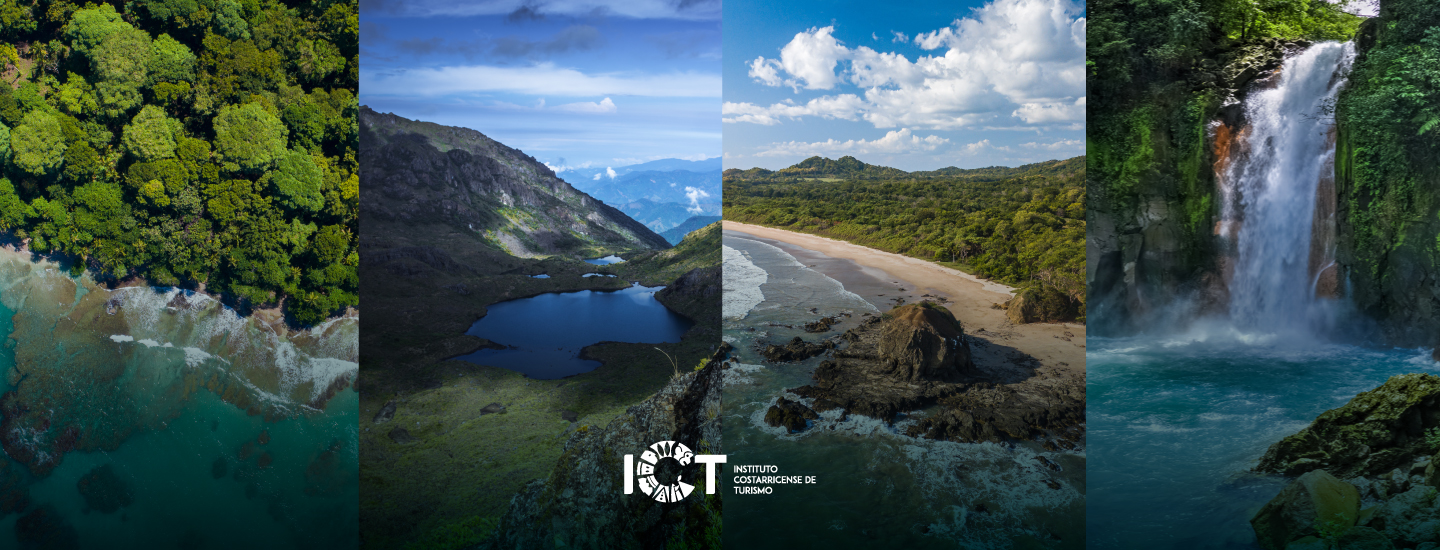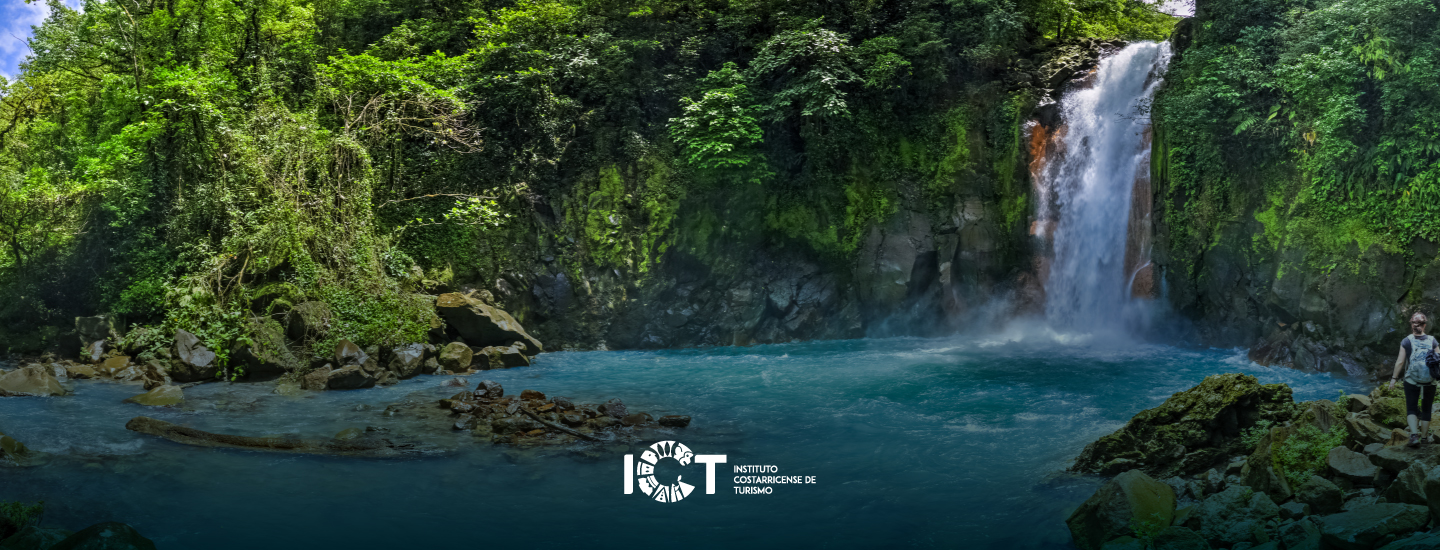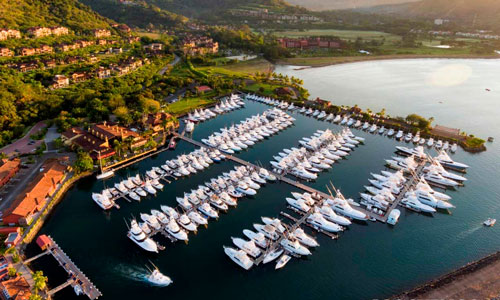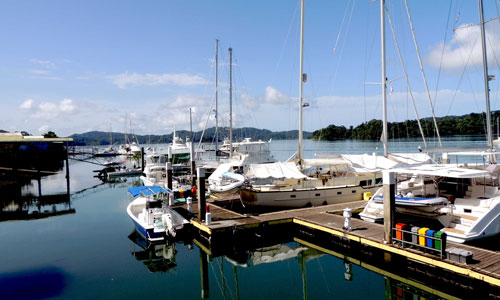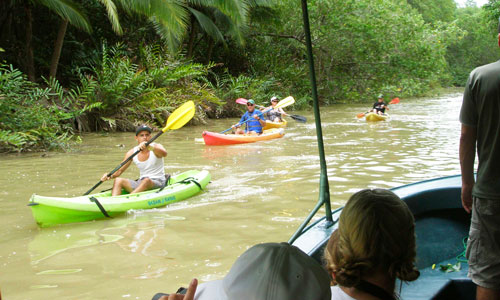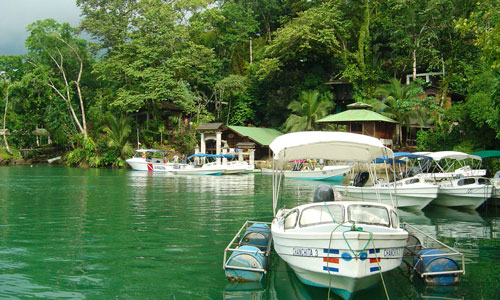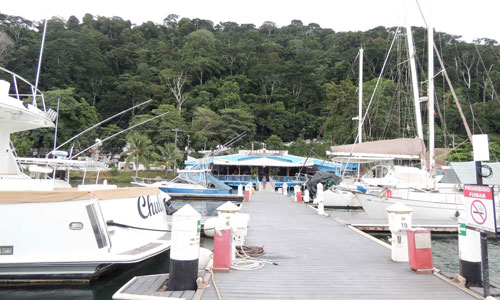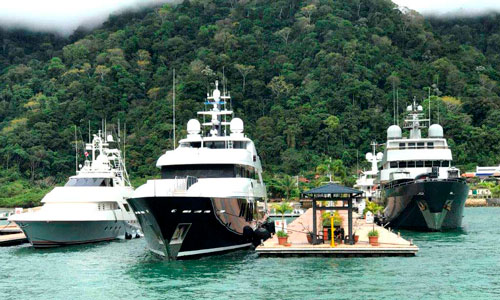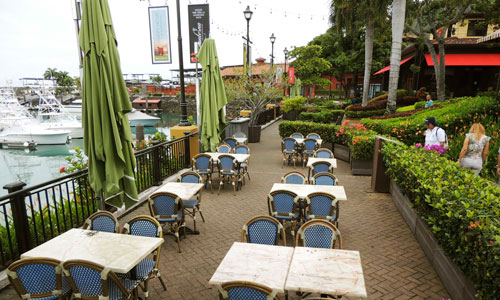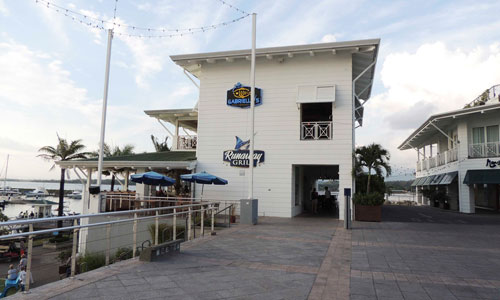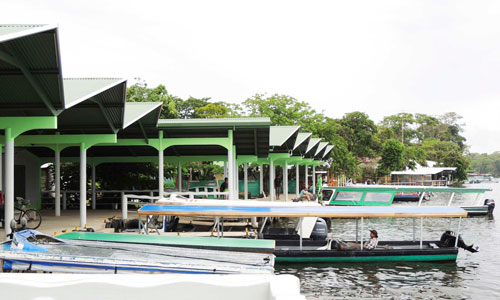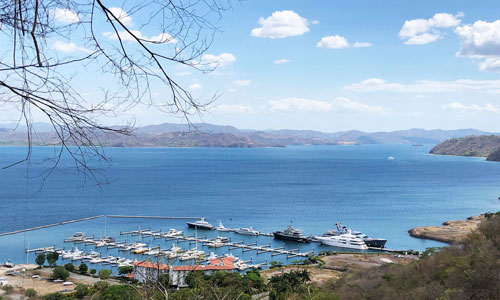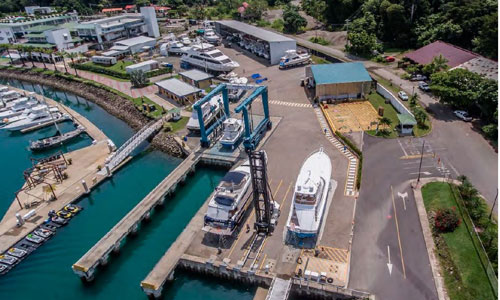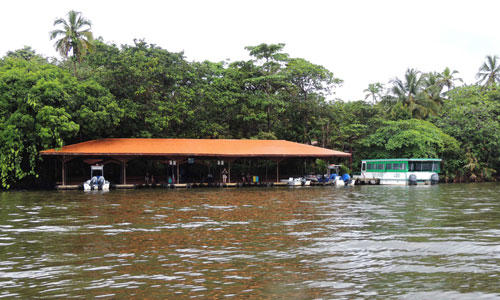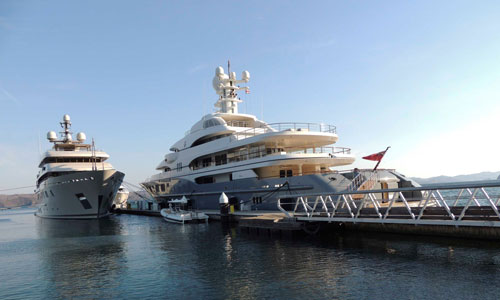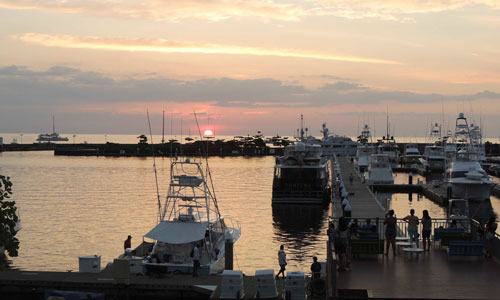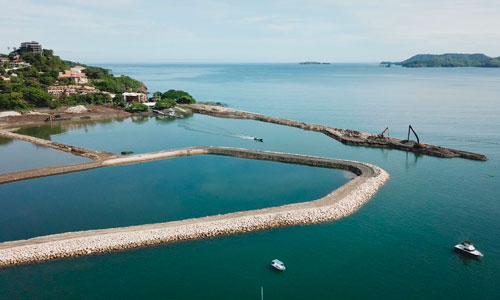CIMAT
General Aspect
The Inter-institutional Commission on Marinas and Tourist Piers (CIMAT) was created in 1998, by Law 7744 and its Regulations. Its legal nature is that of a maximum degree independent body, affiliated to ICT, it also includes representatives from MOPT, MINAE, INVU, and HEALTH (Section 6 of the Law). It is the technical body specialized in the development of marinas and tourism piers.
As part of its attributions, it implements the necessary activities for the control, regulation, and surveillance of concessions, constructions, and operations of these kinds of projects in the country. One of its main functions is to provide technical advice regarding this topic to the Municipalities.
The Commission has a team of professionals from different fields, e.g. engineering, architecture, oceanography, biology, and law, from the Institutions that comprise it. This team evaluates the proposals, visits the sites, and recommends the approval or rejection of the proposals by CIMAT.
Mision y Visión
Visión
"To be the Inter-Agency Body for the supervision, construction and operation of marinas and tourist berths in the country, which allows Costa Rica to be positioned as a quality and environmentally responsible nautical destination."
Misión
"Regulate the development of marinas and tourist berths in the country, in order to ensure a quality, comfortable and safe service, for domestic and foreign vessels, tourists, users and visitors, generating an opportunity for employment aimed at improving the standard of living of Costa Ricans, safeguarding the environment and natural resources of the area."
What is CIMAT?
Law 7744 for the concession and operation of tourist marinas created the Inter-Agency Commission on Marines and Tourist Berths (CIMAT), the only body authorized to oversee the development of marinas and tourist berths in the country and which is consisting of:
- Instituto Costarricense de Turismo.
- Instituto Nacional de Vivienda y Urbanismo.
- Ministerio de Obras Públicas y Transportes.
- Ministerio de Ambiente y Energía.
- Ministerio de Salud.
The commission shall be headquartered at the Costa Rican Institute for Tourism and for the performance of its functions shall have the technical assistance required by the entities that comprise it, which are authorized to designate technical personnel to assist the Commission ( Article 6 of the Law and 15 of the Regulations).
For the performance of its functions, CIMAT has a Board of Directors, an Executive Directorate, a Technical Unit made up of professionals from the different institutions, a Legal Advice and an Administrative Unit (Article 14 Regulations):
Instituto Costarricense de Turismo.
- Doctor Alberto López Chaves, Presidente CIMAT.
- Ingeniero Civil Oscar Villalobos Charpentier, Director Ejecutivo.
- Oceanóloga Roxana Badilla Toruño, Coordinadora Unidad Técnica.
- Arquitecto Francisco Aragón Solórzano, Unidad Técnica.
- Biólogo Marino Ricardo Mora Ugalde, Unidad Técnica.
- Economista Licda. Vivian García Wong, Gestión y Asesoría al Turista.
- Economista Lic. Javier Cordero Valverde, Gestión y Asesoría al Turista.
- Lic. Marlene Marenco Vargas, Asesoría Legal.
- Lic. Monikha Cedeño Castro, Asesoría Legal.
- Srta. Bibiana Vargas Fonseca, Secretaria.
Instituto Nacional de Vivienda y Urbanismo.
- Ing. Civil Edgar Jiménez Mata, miembro Junta Directiva.
- Arq. Lucia Artavia Guzmán, miembro Junta Directiva, suplente
- MAG. Jorge Mora Ramírez, Jefe Departamento de Urbanismo
- Arq. Geovanna Calderón Sánchez, Unidad Criterios Técnicos y Operativos de Ordenamiento Territorial
- Geog. María del Carmen Sibaja Cascante, Unidad Criterios Técnicos y Operativos de Ordenamiento Territorial
Ministerio de Obras Públicas y Transportes.
- Ing. Civil Jorge Hernández Chavarría, Director General de la División Marítimo Portuarias.
- Ing. Ana Yanci Paniagua Cascante, Dirección de Obras Marítimo Portuarias.
- Ing. Civil Braulio Fonseca Ramírez, Dirección de Obras Marítimo Portuarias.
Ministerio de Ambiente y Energía.
- Haydee Rodríguez Romero, Viceministra de Aguas y Mares MINAE
- Licda. Jenny Asch Corrales, Coordinadora Programa Marino Costero, Gerencia de Conservación y uso Costero del SINAC
- Biól. Juan Diego Pacheco Polanco, Auditoría y Seguimiento Ambiental SETENA.
- Biól. Vicente Meza García, MINAE SINAC, Departamento de Prevención, Protección y Control
Ministerio de Salud.
- Ing. Civil Juan Carlos Oreamuno, Unidad Administración de los Servicios de Salud en Ambiente Humano.
- Arq. Gastón Ureña Brenes, Unidad de Normalización en Salud Ambiental.
- Lic. Fernando León Blanco, Unidad Administración de los Servicios de Salud en Ambiente Humano.
CIMAT attributions
To promote that the realization of marine and tourist berth projects in the coastal areas of the country, comply with the corresponding regulations.
Issue the technical decision approving or rejecting the proposed and submitted preliminary draft marine or tourist berth as indicated by the Law and this Regulation.
Establish, by regulation, as indicated in Article 7(c) of the Law, the technical terms of reference to be included in the planning and implementation of the works and in the operation of these projects.
The monitoring, control and control of activities related to the construction, operation and operation of marinas and tourist berths.
Determine the areas that each port area must assign to the State as areas for public use, in accordance with the provisions of the Coastal Regulatory Plan of the area concerned.
Establish your own internal operating rules within the current legal framework.
Who grants a concession?
Municipalities may grant concessions for the development of marinas and tourist berths to natural or legal persons, national or foreign. Any holder of a concession given under this law shall be subject to the national law and jurisdiction of the Costa Rican courts(Article 12 Law 7744).
The concerning concessions relating to the areas of the Gulf of Papagayo Project will be governed by Law 7744 unless the Costa Rican Institute of Tourism will be responsible for granting the concession (Article 25 Law 7744).
Deadline and Canon of Concession
The corresponding Municipality may grant the respective concession contract for the marina or tourist berth, for a maximum period of up to thirty-five years. This period may be extended for periods of ten years each, provided that the following requirements are met:
a) The technical endorsement issued by CIMAT that the interested party has complied with the legal and technical requirements established in this law and the concession contract.
(b) Certification, issued by SETENA, on compliance with environmental commitments.
c) The certification that the interested party is up to date in fulfilling his obligations with the Costa Rican Social Security Fund (CCSS).
The minimum period for which the concession will be granted for marinas shall be fifteen years and five years for tourist berths.
The Municipality, in all cases shall be entitled to collect and receive an annual fee for the concession, of 0.25% on the value of maritime and complementary works on land, built in the concession area, in accordance with article 17 of Law 7 744.
Dealers are required to pay the other authorities the fees, fees or taxes they owe for the construction, administration and operation of marinas or tourist berths.
Definitions
What is a tourist marina?
The whole of facilities, sea or land, intended for the protection, shelter and provision of all kinds of services to recreational, tourist and sporting vessels, of any flag and independent of their as well as visitors and users of them, domestic or foreign.
What are tourist berths?
Tourist berths are landings, fixed or floating docks, ramps and other necessary works in order to allow the docking of tourist, recreational and sports vessels, for the enjoyment and safety of tourists.
What is a Concession?
It is the granting, by the municipalities, of an area of public domain such as in the maritime-terrestrial area and the adjacent area permanently covered by the sea, for the construction and operation of marinas and tourist berths.
Procedures
CIMAT-related laws
How is the Concession of a marina regulated?
Through Law 7744 Concession and Operation of Marines and Tourist Berths, published in Gazette No. 26 of February 1998 and its reform Law 8969 published in Gazette No. 158 of August 2011.
pdf Ley de Concesión y Operación de Marinas y Atracaderos Turísticos. (191 KB)
pdf Reglamento a la Ley de Concesión y Operación de Marinas y Atracaderos Turísticos No.38171-TUR-MINAE-S-MOPT (324 KB)
Below is the list of the laws that make up the Legal Framework within which the actions of the procedures of Marinas and Tourist Berths must be circumscribed:
- Ley de Concesión y Operación de Marinas Turísticas
- Reglamento a la Ley de Concesión y Operación de Marinas Turística
- Ley Forestal #7575
- Ley de Expropiaciones #7495
- Ley Sobre la Zona Marítimo Terrestre #6043
- Ley General de Arrendamientos Urbanos y Suburbanos #7527
- Ley Nacional de Emergencia y Prevención del Riesgo #8488
- Ley Interna de Contratación Administrativa #7494
- Ley Reguladora del Desarrollo y Ejecución del Proyecto Turístico Golfo de Papagayo #6758
- Ley Igualdad de Oportunidades para las Personas con Discapacidad #7600
- Ley General de Administración Pública #6227
- Ley de Protección al Ciudadano del Exceso de Requisitos y Trámites Administrativos Simplificación de Trámites #8220
Although each of these aforementioned laws has some kind of intervention or contribution during the process of a marine and berth project, the activities carried out by CIMAT will follow primarily Law 7744, called the Law on the Grant and Operation of Marinas and Tourist Berths and their Regulations.
Initial Consultation
The initial consultation is mandatory in nature and is intended to guide the interested party on the territorial planning of the area and the physical-environmental studies, which it must provide at the time of its formal request for technical feasibility, based on the specific conditions of the area.
To resolve this procedure, CIMAT will have a maximum period of 20 working days, counted from the day after receipt of all documentation (ART. 28 Regulation).
pdf Solicitud Consulta Inicial (22 KB)pdf Requisitos Marina y Atracadero Consulta Inicial (6 KB)
Technical viability
The Technical Road process allows you to opt for a Concession Application with the municipality or the corresponding entity. For this the responsible professional must justify the technical feasibility of the project taking into account the safe operation of the vessels and the stability of the works and the knowledge of the degree of impact on the environment. Preliminary studies should be submitted to justify the scope of the proposal and its technical feasibility, in requirements such as coat works, characteristics of material sources, interaction of works and the environment, mitigation measures and description detailed works.
Once the technical feasibility has been advanced, the assessment of the Environmental Impact Assessment, duly approved by SETENA, has been completed, in addition to meeting the requirements referred to in Article 5 of the Law, CIMAT will issue the final decision on the approval for the interested party to initiate the process of granting to the municipality or respective entity.
The deadline for CIMAT to rule is forty-five working days from the receipt of all required documents (Art. 5 of the Law and 30 to 33 of the Regulations).
pdf Solicitud Viabilidad Técnica (36 KB)pdf Requisitos Marina y Atracadero Viabilidad Técnica (92 KB)
Constructive Plans Visa
Once the concession has been granted and registered, the concessionaire will have a period of one hundred and twenty calendar days to submit to the CIMAT one-stop shop the necessary documents for the visa process of construction plans. In the event that the proposal is submitted in stages or phases, a schedule of execution of works with all stages, as stipulated in article 9a of the Law, must be provided.
The deadline for CIMAT to resolve is forty working days from the receipt of all requested requirements (Article 9a of the law, art. From 51 to 58 Regulations).
pdf Formulario de Solicitud Marinas (34 KB)pdf Formulario de Solicitud de Atracaderos (33 KB)
pdf Requisitos de Marinas (11 KB)
pdf Requisitos de Atracaderos (8 KB)
Legalization of Existing Berths
In accordance with Transitional I of the Regulations to Law 7744, natural or legal persons who built and operate, tourist berths and do not involve modifications, shall have a period of 24 months to initiate the process of approving the concession and the permission to SETENA shall be governed by the simplified procedure established.
pdf Guia de Inspección (46 KB)
pdf Guía para la legalización de atracaderos existentes (194 KB)
Concession Extension
To extend the period of the concession, the interested party must submit a formal application to the Municipality or corresponding agency with an advance not less than six months of expiration and meet the following requirements:
a) CIMAT's technical endorsement
b) Certification issued by SETENA on compliance with environmental commitments.
c) That the interested party meets with the Costa Rican Social Security Fund.
Article 11 of the Law and 44 of the Regulations
Aval técnico de CIMAT
Control
According to Article 7 of Law 7744 within the powers of the Interinstitute Commission of Marines and Tourist Berths to CIMAT, it is responsible for, inter alia: the monitoring, control and control of activities related to the subject matter of the this law.
Constructive Stage
The construction of a marina or tourist berth involves the Marinachoosing a suitable site and the construction of a series of maritime or land facilities for the protection and provision of services to vessels and visitors. For the construction stage the interested party must start the works in the term indicated in the concession contract. The start date of works must be communicated 10 days in advance (Article 57 of the Regulations), for which CIMAT will schedule bi-monthly visits to audit the construction process, the marina shall make and submit the reports of the construction stage every two months in print and digital format (Article 58 Regulation).
Operational Stage
The concessionaire must inform the municipality and CIMAT of the date of completion of the works for receipt, formal approval and Marinagranting of the operating health permit by the corresponding institution. The Municipality of the sector must grant the licenses that are required for the proper functioning of the marine and tourist berth projects (Article 60 and 61 regulations). From the date of the start of operation, the marina shall submit operating reports every six months in both print and digital format (Article 63 regulations).
Any marina or tourist berth will have an administrator who will be responsible for the correct use and management of the goods and services provided by the marina and will be responsible for coordinating with the public officials present in them regarding the control and port surveillance (Article 04 of the regulations).
Any marina shall have prior to its start of operation with an internal regulation approved by CIMAT which must contain at least the following (Article 62 of the Rules of Procedure):
- Preventive and mitigation plans for emergency situations (fire, fuel spills, maritime accidents, boat sinking, search and rescue).
- Indication of equipment available to deal with the above-mentioned emergencies.
- Procedure for use of Government Office.
- Environmental Standards derived from the Management Plan and Affidavit of Environmental Commitments.
Information and Studies
a. Map of Marinas and Tourist Berths
image Mapa (343 KB)b. Environmental Characterization
Environmental Characterization for the Development of Marines and Tourist Berths on Costa Rica's Pacific and Caribbean Coast
Maps of Integrated Land and Marine Environmental Frailty Indexes
Introduction
Guanacaste
Mapas Guanacaste
-
pdf 2DA5 mapa75 16v ifa integrado Popular
-
pdf 7B5B mapa75 16v IFAmar integrado Popular
-
pdf A427 mapa75 17h ifa integrado Popular
-
pdf E5A3 mapa75 17h IFAmar integrado Popular
-
pdf A04A mapa75 18v IFAmar integrado Popular
-
pdf 7B83 mapa75 18v ifa integrado Popular
-
pdf C7B5 mapa75 19v ifa integrado Popular
-
pdf 7944 mapa75 19v IFAmar integrado Popular
-
pdf 524E mapa75 20v IFAmar integrado Popular
-
pdf 7815 mapa75 20v ifa integrado Popular
Pacífico Medio
Mapas Pacífico Medio
-
pdf E428 mapa75 10v IFAmar integrado Popular
-
pdf CC4C mapa75 6v IFAmar integrado Popular
-
pdf C9B4 mapa75 8h IFAmar integrado Popular
-
pdf A8D1 mapa75 9h ifa integrado Popular
-
pdf 8F7B mapa75 8h ifa integrado Popular
-
pdf 8CE5 mapa75 10v ifa integrado Popular
-
Image 8B46 06 Mapa de IFA Integrado Popular
-
pdf 7F5B mapa75 8h IFAmar integrado Popular
-
pdf 7CC0 mapa75 7h ifa integrado Popular
-
pdf 7A3B mapa75 8h IFAmar integrado Popular
Pacífico Sur
Mapas Pacífico Sur
-
pdf F9E5 mapa75 3h IFAmar integrado Popular
-
pdf F00C mapa75 2v ifa integrado Popular
-
pdf E211 mapa75 3h ifa integrado Popular
-
pdf C40F mapa75 2v IFAmar integrado Popular
-
pdf B229 mapa75 4a h ifa integrado Popular
-
pdf 8E29 mapa75 4a h IFAmar integrado Popular
-
pdf 5AAB mapa75 1v IFAmar integrado Popular
-
pdf 1F32 mapa75 1v ifa integrado Popular
Puntarenas e Islas del Golfo
Mapas Puntarenas e Islas del Golfo
-
pdf CA40 mapa75 11v ifa integrado Popular
-
pdf C8A4 mapa75 14h ifa integrado Popular
-
pdf A53D mapa75 12h ifa integrado Popular
-
pdf 9B9B mapa75 13h IFAmar integrado Popular
-
pdf 9B17 mapa75 14h IFAmar integrado Popular
-
pdf 761D mapa75 12h IFAmar integrado Popular
-
pdf 6C8A mapa75 15h IFAmar integrado Popular
-
pdf 6C24 mapa75 13h ifa integrado Popular
-
pdf 2758 mapa75 15h ifa integrado Popular
-
pdf 0B18 mapa75 11v IFAmar integrado Popular
Caribe
Mapas Caribe
-
-
-
Image AED3 01 Mapa de IFA Integrado Popular
-
Image 91D7 04 Mapa de IFA Integrado Popular
-
Image 8B72 02 Mapa de IFA Integrado Popular
-
Image 8B46 06 Mapa de IFA Integrado Popular
-
-
-
-
Image 33C0 05 Mapa de IFA Integrado Popular
c. Estudios sobre Impacto Socioeconómico de las marinas
- pdf Impacto socioeconómico que causaría el cierre de Marina Flamingo (212 KB)
- pdf Impacto socioeconómico de Marina Los Sueños (676 KB)
- pdf Posible impacto socioeconómico de construcción de marinas en Corcovado Golfito (585 KB)
- pdf Estudio sobre el impacto laboral de la operación de La Marina Los Sueños en Playa Herradura (2.52 MB)
- pdf Estudio del perfil del turista que practica pesca deportiva y turística, a realizarse en los Aeropuertos Internacionales y en La Marina Los Sueños (3.60 MB)
d. Criterios para catastro de planos
The National Catastro will record all plans of surveying concerning the concessions of the marinas or tourist berths that are submitted to the registration process, when they comply with all the requirements derived from the Catastro Law Land Maritime Zone Law, the Law regulating the Development and Implementation of the Papagayo Gulf Tourism Project, and the Tourism Marine Concession and Operation Act, as well as any other applicable regulations.
e. Guía de Buenas Prácticas para la Pesca Deportiva y Turística
Sport and Tourist Fishing can, in many cases, arouse an interest in conservation since the activity depends on the good state of the marine-coastal resource. However, the lack of follow-up of good practices and environmental responsibility by a few fishermen may affect others and the resource itself. We know that there are ways to contribute to the sustainability of marine-coastal resources and these fishing modalities, so here we present a Good Practice guide that serves sport fishermen, tourists and related actors.
f. Consumo Responsable de Pescado y Marisco
The threat of a world without fish is now a reality that must worry governments, fishermen, entrepreneurs, decision makers, tourists and other sea users. 80 per cent of fish stocks for which information exists are fully exploited or over-exploited and have been severely reduced, quoted in Breviary for Responsible Fish and Seafood Consumption, Mar Viva.
g. Guía de Buenas Prácticas para la Construcción y Operación de Marinas Turísticas en Costa Rica
Tourist marinas provide the necessary infrastructure for the proper functioning of recreational and tourist activities related to nautical activity. These offer services such as: drinking water, electric power, Internet, boat maintenance, minor repairs, sanitary services, wastewater treatment plant, waste collection and disposal and vehicle parking. In addition, they are a source of jobs (direct and indirect), for recreational tourism and sport fishing.
Contact CIMAT
Comisión Interinstitucional de Marinas y Atracaderos Turísticos
Instituto Costarricense de Turismo
Tels. (506) 2299-5800 / 2299-5934 y Fax (506) 2290-3347
La Uruca San José Costa Rica
